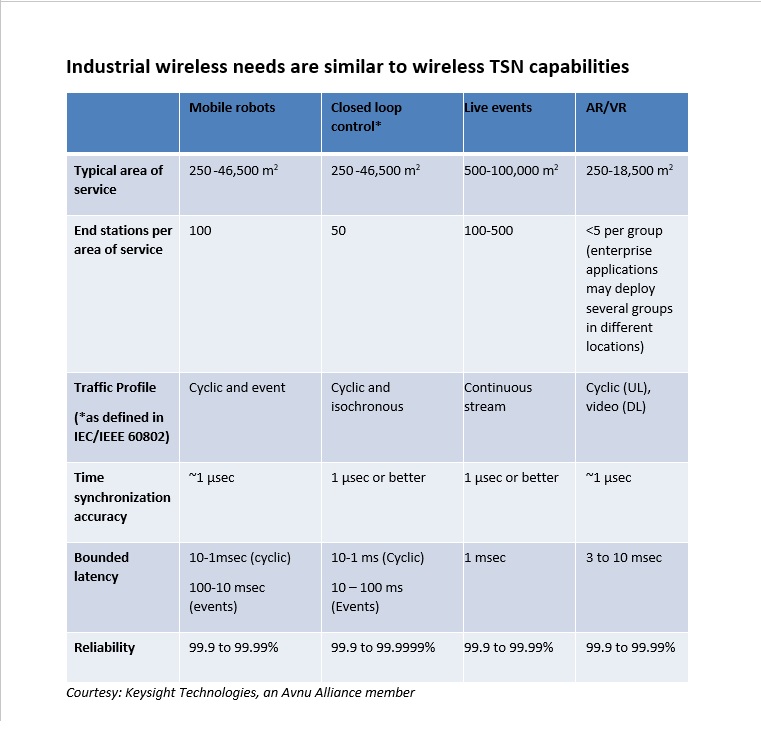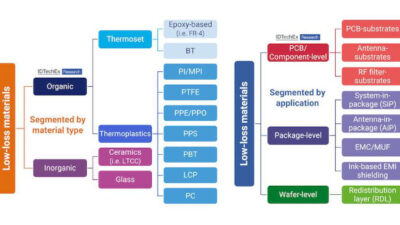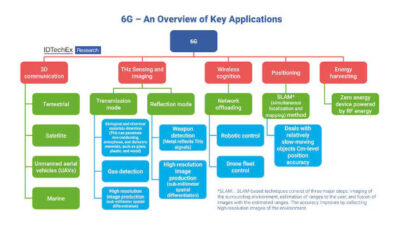Standards and implementation for Wi-Fi and 5G support time-sensitive networking. Table compares industrial wireless and wireless TSN capabilities.

Learning Objectives
- Understand how wireless time-sensitive networks (WTSN) can help manufacturers improve communications.
- Learn about the different standards required for WTSN.
- Learn how converged networks can let different data traffic exist on the same physical network.
Wireless TSN insights
- Wireless time-sensitive networking (WTSN) offers many benefits such as flexible deployments, mobility and reconfigurability, which are crucial in manufacturing environments as operations become more mobile.
- WTSN applications have to adhere to strict security best practices when it comes to authentication, integrity, confidentiality and more. This is needed as modern manufacturing devices often have internet capabilities built in or as legacy devices are given internet connectivity.
Recent advances in Wi-Fi and 5G have made it clear that wireless networks are capable of supporting time sensitive networking (TSN)-grade performance. Benefits for wireless TSN (WTSN) in industrial automation include flexible deployment, reduced maintenance costs, reconfigurability and mobility.
Over the next few years, we can expect accelerating adoption of WTSN infrastructure for closed-loop control, industrial robots, automated guided vehicles, and other industrial applications. WTSN is a key enabling technology to make Industry 4.0 implementations more nimble and efficient.
While WTSN capabilities are coming to industrial networks, they won’t all roll out at once or meet exactly the same key performance indicators (KPIs) as wired networks.
Avnu Alliance, a community open to organizations interested in advancing the deployment of TSN-based open standards, released a white paper outlining key performance indicators (KPIs) for WTSN applications, including industrial robots and closed loop control as well as real time media transport for live events and AV/VR systems. Focusing on time synchronization, bounded latency, reliability, security and capacity, the white paper outlined the most crucial aspects of WTSN applications and identified broad requirements representative of overall market expectations.
Common ground in wireless time-sensitive networking market expectations
As we researched the market expectations of diverse industries, a very interesting theme emerged: Despite a wide range of typical service areas and a variety of traffic profiles, KPIs for industrial applications are broadly similar to those for other high-priority WTSN applications.
WTSN applications also are expected to adhere to industry-recommended security best practices, including with respect to authentication, integrity, confidentiality, availability and resiliency to potential interference or attacks.
Many wireless applications, across different markets, can be addressed with a time-synchronization accuracy requirement of about 1 µsec, which is within the current capabilities of 5G and Wi-Fi networks: IEEE 802.AS clock synchronization is enabled by the current release of the IEEE 802.11 Wi-Fi standard and supported by 3GPP Rel 16.
Bounded latency requirements for wireless applications are often 10 ms or less, making traffic shaping another high priority feature for WTSN. TSN traffic shaping is enabled by the IEEE 802.1Qbv (Time-aware shaper) standard. IEEE 802.1Qbv defines a set of timed gates to control the queues associated with multiple traffic classes on an TSN bridge. It offers predictable data delivery performance, which is critical in industrial use cases. IEEE 802.1Qbv can operate in combination with the latest Wi-Fi scheduling capabilities available in Wi-Fi 6/6E and 5G systems.
All high-priority WTSN use cases have reliability requirements well in excess of general consumer or workplace network applications. In the time- and safety-critical scenarios common to Industrial applications, reliability can be ensured via the IEEE 802.1CB Frame Replication and Elimination for Reliability (FRER) standard. FRER uses data replication on multiple paths, reducing the impact of individual device/link failures. FRER is transparent to the MAC/PHY network layers, so it can function on either 5G or Wi-Fi wireless networks, though implementation may differ across system types.
There is common ground among WTSN applications across industries, which means these similar base requirements mean a larger addressable market for silicon and device manufacturers, speeding the pace of industry innovation. It also means WTSN network could support multiple different traffic types. This is likely the future: Converged industrial networks with multiple traffic types and classes, including wired and wireless, time-sensitive and time-elastic, reliable and loss-tolerant applications.

Mixed criticality industrial networks, wired and wireless
Converged networks will allow different data traffic to coexist on the same physical network, across wired and wireless mediums. True convergence will enable the management of multiple traffic types on the same wire, allowing more efficient infrastructure and network management. That’s desirable, but it’s not straightforward. Converged networks will require the exchange of different classes of traffic and the coexistence of different traffic types and devices, all managed by IT, OT and media professionals.
Plugfests, demonstrations to verify wired, wireless TSN interoperability
Avnu Alliance plugfests, demonstrations and test plans help verify performance and interoperability of wired and wireless TSN devices. During the 8th annual TSN/A Conference in Stuttgart, Germany, Avnu hosted demonstrations in its booth of TSN tests for IEEE 802.1AS and IEEE 802.1Qbv. These tests were run onthe Avnu Express Test Tool and on Keysight’s new TSN Test Tool. Demonstrations will include wired and wireless TSN tests.
Avnu Alliance also will be presenting at Wireless Congress 2022 this November in Munich on WTSN Interoperability Testing and Integration with Wired TSN. The events help teach how wired and wireless TSN systems may be built, configured, and verified. Silicon vendors, network infrastructure providers, and device manufacturers also are encouraged to join Avnu Alliance to add to the verifiable TSN toolbox.
Martin Gubow, TSN program manager, Keysight Technologies. Edited by Chris Vavra, web content manager, Control Engineering, CFE Media and Technology, [email protected].
MORE ANSWERS
Keywords: TSN, time-sensitive networking, wireless networks
CONSIDER THIS
What considerations do you have for wireless networking at your facility?



